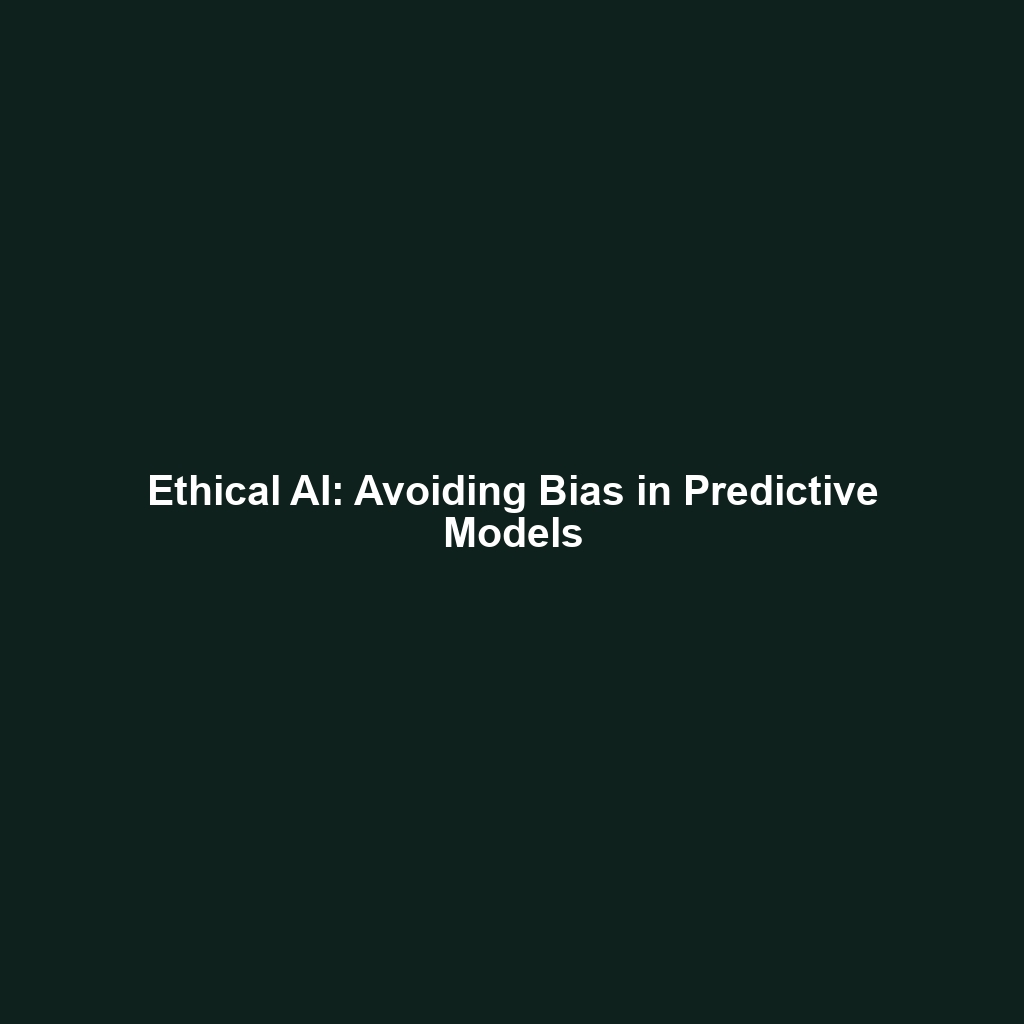Predictive analytics, the art and science of using data to forecast future outcomes, has become an indispensable tool for businesses across all sectors. From predicting customer churn to optimizing supply chains, the potential benefits are enormous. However, this power comes with significant ethical responsibilities. Ignoring these responsibilities can lead to biased outcomes, discriminatory practices, and a loss of public trust. This article delves into the critical ethical considerations surrounding predictive analytics, providing guidance on how to develop and deploy models responsibly.
The Ethical Minefield: Key Challenges in Predictive Analytics
The path to leveraging predictive analytics is not without its potential pitfalls. Understanding the core ethical challenges is the first step towards responsible implementation.
Algorithmic Bias: The Ghost in the Machine
Algorithmic bias occurs when a predictive model produces unfair or discriminatory outcomes due to biased data, flawed algorithms, or biased design choices. This can manifest in various ways:
- Historical Bias: Training data reflects existing societal biases, leading the model to perpetuate those biases. For example, if historical hiring data shows a disproportionate number of men in leadership roles, a model trained on this data might unfairly favor male candidates for future promotions.
- Sampling Bias: The training data is not representative of the population the model is intended to serve. Imagine a model predicting loan defaults trained primarily on data from urban areas. It might perform poorly when applied to rural populations with different economic circumstances.
- Measurement Bias: The features used in the model are measured or collected in a way that systematically disadvantages certain groups. For instance, using zip codes as a proxy for socioeconomic status can perpetuate existing inequalities, as zip codes are often correlated with race and ethnicity.
Key Insight: Algorithmic bias is not just a theoretical problem; it has real-world consequences. Biased predictive models can reinforce systemic inequalities, leading to unfair outcomes in areas such as hiring, lending, and even criminal justice.
I once consulted with a company that developed a predictive model to screen job applicants. The model, trained on historical hiring data, inadvertently penalized applicants who attended historically Black colleges and universities (HBCUs). This was because the model associated these institutions with lower performance, based on past hiring patterns. The company was shocked to discover this bias and immediately took steps to retrain the model with a more diverse and representative dataset, as well as removing features that could indirectly discriminate against applicants from HBCUs.
Data Privacy: Protecting Sensitive Information
Predictive analytics often relies on vast amounts of personal data, raising serious privacy concerns. It’s crucial to handle this data responsibly and ethically, adhering to privacy regulations like GDPR and CCPA. Key considerations include:
- Data Minimization: Collecting only the data that is strictly necessary for the model’s purpose. Avoid collecting and storing data that is irrelevant or could be used for unintended purposes.
- Anonymization and Pseudonymization: Protecting individuals’ identities by removing or masking identifying information. While anonymization aims to make data completely unidentifiable, pseudonymization uses techniques like hashing to replace identifying information with pseudonyms, allowing for re-identification under specific circumstances.
- Data Security: Implementing robust security measures to protect data from unauthorized access, use, or disclosure. This includes encryption, access controls, and regular security audits.
- Transparency and Consent: Being transparent with individuals about how their data is being used and obtaining their informed consent. This involves providing clear and concise privacy policies and giving individuals control over their data.
A large retailer I worked with wanted to use purchase history to predict which customers were likely to become pregnant. While this information could be valuable for targeted marketing, the ethical implications were significant. We advised them to abandon the project due to the potential for privacy violations and the risk of alienating customers. Instead, we helped them develop more general models based on broader purchasing patterns, without explicitly targeting potentially sensitive customer characteristics.
Transparency and Explainability: Opening the Black Box
Many predictive models, especially complex machine learning algorithms, are often described as “black boxes.” It can be difficult to understand how the model arrived at a particular prediction, making it challenging to identify and address potential biases. Increasing transparency and explainability is crucial for building trust and ensuring accountability.
- Model Explainability: Using techniques like SHAP (SHapley Additive exPlanations) values or LIME (Local Interpretable Model-agnostic Explanations) to understand which features are most influential in the model’s predictions.
- Transparency in Model Development: Documenting the data sources, preprocessing steps, and model architecture. This allows others to review and scrutinize the model for potential biases or flaws.
- Communicating Model Limitations: Being upfront about the model’s limitations and potential errors. Avoid overstating the model’s accuracy or predictive power.
Key Insight: Explainable AI (XAI) is becoming increasingly important as predictive models become more complex. XAI techniques help to demystify the “black box” and provide insights into how the model is making decisions.
I recall a project where we developed a model to predict loan defaults for a financial institution. The model was highly accurate, but the decision-makers were hesitant to implement it because they didn’t understand how it worked. We invested time in explaining the model’s logic and using techniques to identify the key factors driving its predictions. This increased transparency ultimately led to greater trust in the model and its successful deployment.
Developing and Deploying Predictive Models Responsibly: A Practical Guide
Addressing the ethical challenges of predictive analytics requires a proactive and systematic approach. Here’s a practical guide to help you develop and deploy models responsibly:
1. Define Clear Ethical Guidelines and Principles
Establish a clear set of ethical guidelines and principles that will guide the development and deployment of predictive models. These guidelines should be aligned with your organization’s values and legal requirements. Consider addressing issues such as fairness, privacy, transparency, and accountability.
- Fairness: Define what fairness means in the context of your specific application. This may involve considering different notions of fairness, such as equal opportunity, equal outcome, or demographic parity.
- Privacy: Adhere to all applicable privacy regulations and ensure that data is handled responsibly and ethically.
- Transparency: Strive to make your models as transparent and explainable as possible.
- Accountability: Establish clear lines of accountability for the development and deployment of predictive models.
2. Conduct a Thorough Data Audit
Before training a predictive model, conduct a thorough audit of your data to identify potential biases. This includes examining the data sources, data collection methods, and data preprocessing steps. Look for evidence of historical bias, sampling bias, and measurement bias.
- Analyze Data Distributions: Compare the distributions of key features across different demographic groups to identify potential disparities.
- Identify Missing Data: Investigate patterns of missing data to determine if certain groups are disproportionately affected.
- Assess Data Quality: Ensure that the data is accurate, complete, and consistent.
3. Mitigate Bias During Model Development
Take steps to mitigate bias during the model development process. This may involve using techniques such as:
- Data Augmentation: Increasing the size and diversity of the training data by generating synthetic data points.
- Reweighting: Assigning different weights to data points from different groups to balance the training data.
- Adversarial Debiasing: Training a separate model to predict sensitive attributes (e.g., race, gender) and then using that model to penalize the primary model for making predictions that are correlated with those attributes.
- Fairness-Aware Algorithms: Using algorithms that are specifically designed to promote fairness.
4. Evaluate Model Fairness
Evaluate the fairness of your predictive model using appropriate metrics. There are many different fairness metrics to choose from, and the best metric will depend on the specific application and the definition of fairness that you have adopted.
- Equal Opportunity: Ensuring that different groups have an equal chance of being correctly classified as positive.
- Equal Outcome (Demographic Parity): Ensuring that different groups have the same proportion of positive predictions.
- Predictive Parity: Ensuring that the accuracy of positive predictions is the same across different groups.
Key Insight: There is no single “best” fairness metric. The choice of metric should be guided by the specific context and the potential impact of the model’s predictions.
5. Implement Monitoring and Auditing Procedures
Once the model is deployed, implement ongoing monitoring and auditing procedures to ensure that it continues to perform fairly and ethically. This includes regularly checking for bias drift, monitoring the model’s performance on different demographic groups, and conducting periodic audits of the model’s data and code.
6. Foster a Culture of Ethical AI
Promote a culture of ethical AI within your organization. This includes providing training to employees on ethical considerations in predictive analytics, establishing clear channels for reporting ethical concerns, and encouraging open discussion about ethical issues.
Case Studies: Ethical Failures and Successes
Examining real-world examples of ethical failures and successes can provide valuable insights and lessons learned.
Ethical Failure: COMPAS Recidivism Prediction
The COMPAS (Correctional Offender Management Profiling for Alternative Sanctions) algorithm, used to predict recidivism rates in the US criminal justice system, has been widely criticized for its racial bias. Studies have shown that COMPAS is more likely to falsely flag Black defendants as high-risk, while falsely flagging white defendants as low-risk. This bias can have serious consequences, as it can influence decisions about bail, sentencing, and parole.
The problem stemmed from the fact that the algorithm was trained on historical data that reflected existing racial disparities in the criminal justice system. As a result, the algorithm learned to associate certain characteristics with race, leading to biased predictions.
Ethical Success: ProPublica’s Machine Bias Investigation
ProPublica’s investigation into the COMPAS algorithm is a prime example of how investigative journalism can hold organizations accountable for the ethical implications of their AI systems. Their rigorous analysis and reporting brought widespread attention to the issue of algorithmic bias and prompted a national conversation about fairness in AI.
This case highlights the importance of transparency and accountability in the development and deployment of predictive models. It also demonstrates the power of independent audits and investigations to uncover and address ethical concerns.
The Future of Ethical Predictive Analytics
The field of ethical predictive analytics is constantly evolving. As AI technology advances, new ethical challenges will emerge. Here are some key trends to watch:
- Increased Regulatory Scrutiny: Governments around the world are increasingly focused on regulating AI to ensure that it is used ethically and responsibly. The EU’s AI Act is a prime example of this trend.
- Advancements in XAI: Researchers are developing new techniques to make AI models more transparent and explainable. This will help to identify and address potential biases.
- Focus on Data Governance: Organizations are increasingly recognizing the importance of data governance in ensuring ethical AI. This includes establishing clear policies and procedures for data collection, storage, and use.
- Growing Public Awareness: Public awareness of the ethical implications of AI is growing. This will put pressure on organizations to develop and deploy AI systems responsibly.
Predictive analytics offers immense potential for businesses, but it’s crucial to proceed with caution and awareness. By prioritizing fairness, privacy, transparency, and accountability, we can harness the power of data while upholding ethical principles. The future of predictive analytics depends on our commitment to building a responsible and trustworthy AI ecosystem. If you’re interested in exploring how our team can help your organization navigate the complexities of ethical AI and build responsible predictive models, contact us today.
This article was optimized and published by Content Hurricane.


